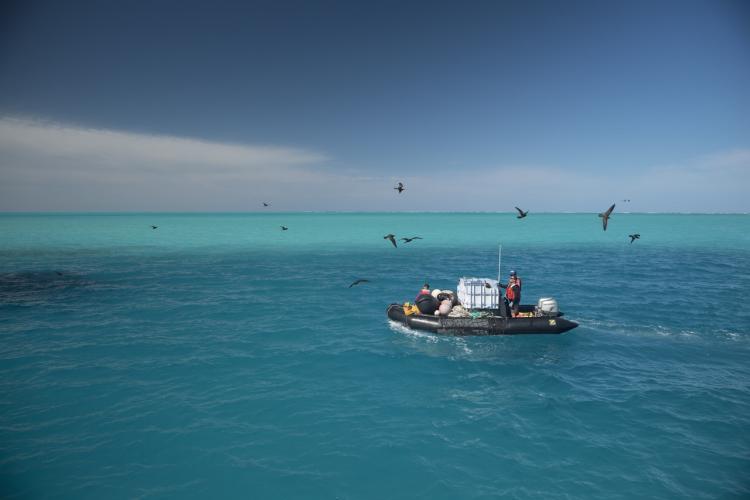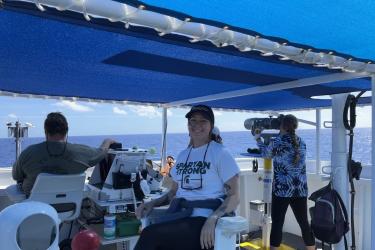Imagine all the most beautiful, different blue shades in water, visibility to the ocean floor, and healthy reefs filled with fish. Welcome to Midway Atoll!
After dodging a hurricane by leaving Pearl and Hermes Atoll a day early, we pulled into the picturesque pier at Midway Atoll. Midway’s limo service (8-seater golf carts) greeted and escorted us to pick up our bikes for island transportation. We unloaded all of our gear and said goodbye to the floating home NOAA Ship Oscar Elton Sette that we loved so much. Next, we collect marine debris in the water and around the shores of Sand, Eastern, and Spit Islands of Midway Atoll.

We were pleasantly surprised that we had AMAZING weather for the next couple days. The waters in the atoll looked like a lake—calm and serene. With amazing weather like this, what are we to do? Time to towboard! If you’ve been following along, you already know about towboarding (a fan favorite here on the marine debris team), but, just in case you haven’t… towboarding is when two snorkelers hold onto a wooden “towboard” attached to a motoring boat, and fly through the water to look for derelict fishing gear on the reef. Even on calm days where you can see the bottom, we still find many nets that you can’t see from the surface.

While towboarding, this is the spotter’s view looking back on the snorkelers in the water. The spotter is the person on the boat with the coxswain (captain) to make sure the towboarders are safe and to help guide the coxswain.

Once the weather turned a bit, we decided it was time to clean up the islands. Our team may look and act like a school of fish, but we have land legs, too, and were excited to clean up some important habitat on land. We started with Eastern Island, the second largest, and then made our way to Spit Island (the smallest).


Seeing these pristine beaches littered with debris is a bit depressing, but our team feels awesome when we get to drive back by the beaches to see how much cleaner they are once we have been there. In just one week here, we collected more than 33,000 pounds of debris from land and sea! Returning days later, there’s already new debris washing ashore. Remember that while cleanups are great, extremely helpful and important, only reducing or refusing plastics will help prevent this problem. Our animals are depending on it and so are we... for a future free of debris.
Meet the Blogger

Kelly Williams
Kelly earned her master’s degree in Zoology from University of Hawai‘i at Mānoa researching shark sensory biology and behavior. If she is not in the water, Kelly is outdoors adventuring or with friends and family. Kelly is excited to get back to the Northwestern Hawaiian Islands, remove as much marine debris as possible, and bring awareness to this global issue.
You can make a difference
Minimize plastics in everyday items you purchase by seeking minimal, sustainable, or biodegradable packaging for deodorants, soaps, and shampoos.
Follow us
Follow the team as they travel to the islands and atolls of the Northwestern Hawaiian Islands with photos and updates on their Story Map.
Partners
NOAA Fisheries marine debris project in the Pacific Islands region is supported by NOAA (Pacific Islands Fisheries Science Center, Pacific Islands Regional Office, Marine Debris Program, and the Damage Assessment Remediation and Restoration Program) in partnership with the University of Hawaii's Joint Institute for Marine and Atmospheric Research, National Fish and Wildlife Foundation, U.S. Fish and Wildlife Service, Midway Atoll National Wildlife Refuge, the State of Hawaii’s Department of Land and Natural Resources, and the Papahānaumokuākea Marine National Monument.

